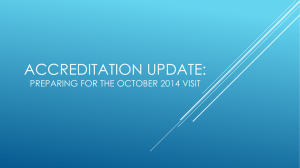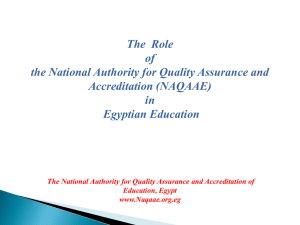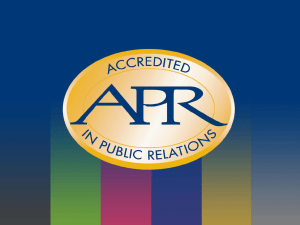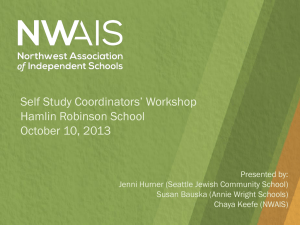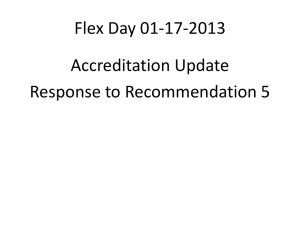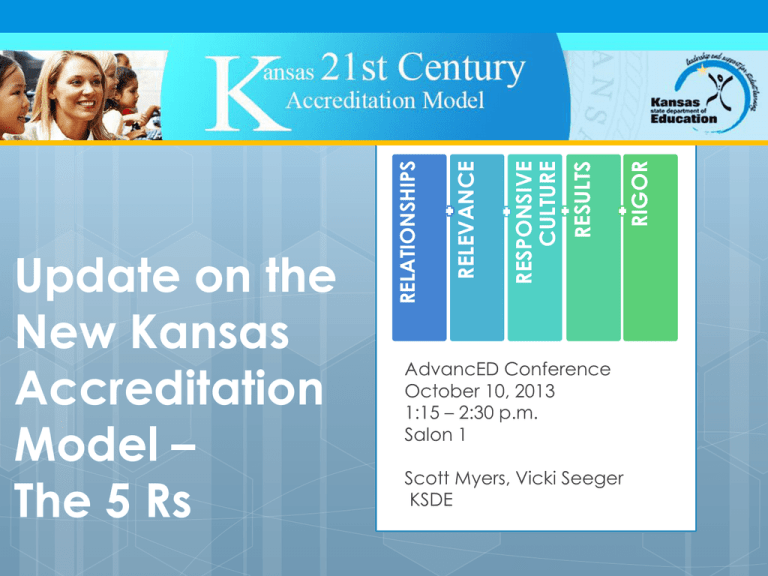
AdvancED Conference
October 10, 2013
1:15 – 2:30 p.m.
Salon 1
Scott Myers, Vicki Seeger
KSDE
RIGOR
RESULTS
RESPONSIVE
CULTURE
RELEVANCE
RELATIONSHIPS
Update on the
New Kansas
Accreditation
Model –
The 5 Rs
Accreditation
Defining the 5 Rs – Fifth R
Results
Growth in
Achievement
Student
Data
Achievement
Reduced
Gaps in
Student
Achievement
Other
Measures
“Focusing on results—witnessable evidence of growth and learning—allows curriculum
and instruction to be delivered in a timely fashion based on the needs and desires of the
individual learner. Informative and summative assessment, coupled with research-based
effective teaching practices, can provide the data and information necessary to fuel
teaching and empower learning (KSDE, 2010, p. 46).”
Accreditation
Annual Measurable Objectives
(AMOs)
The Annual Measurable Objectives (AMOs) as outlined in the ESEA
Waiver (2012), established the following measures:
1.
2.
3.
4.
5.
6.
high achievement data using the Assessment Performance Index;
growth in student achievement using the Student Growth
Percentile Model;
reduced gaps in achievement using the Assessment Performance
Index;
proficiency using a Reduction in the Non-proficient Performance
levels;
participation rate in state assessments; and
graduation rates.
The goal for every district in the State of Kansas is to achieve 21st
Century accreditation and for all students to be college and career
ready upon graduation from a Kansas high school.
Annual Measurable Objectives
What are the 6 AMOs?
Each building will have an AMO
for achievement, growth,
reduction of non-proficient,
gap and participation
High school buildings will have
an AMO for graduation
All targets are based on 20112012 data
Accreditation
As we think about accreditation,
we need to keep in mind the
definition of Kansas College and
Career Ready:
College and Career Ready means an individual has the
academic preparation, cognitive preparation, technical skills,
and employability skills to be successful in postsecondary
education, in the attainment of an industry recognized
certification or in the workforce, without the need for
remediation.
Accreditation
Current Objectives
Updates have been
made to:
•
•
•
•
•
•
•
In Depth Rubric Revisions
Definitions of
Relationships, Relevance,
Responsive Culture, Rigor,
Results
Definitions of the sub-R’s
QPA Protocol Handbook
Evidence
Web Page
QPA Regulations
Accreditation
District Accreditation Cycle:
Interim Year
Foundational
Elements:
•
•
•
•
•
•
•
•
•
Licensed Educators
KAR 91-31-34
State Law
Local Graduation Policies
School Improvement Plan
Secondary Programs and
Services
External Assistance Team
Curricula
Programs and Services
Performance
Elements:
•
•
•
•
Yes on Achievement,
Growth, or Gap
95% of students are
tested
Graduation Rate
Attendance Rate
Accreditation
District Accreditation Cycle:
Year One
•
5Rs Rubrics are completed by the districts
•
Evidence submitted to repository to support
ratings on the 5Rs rubrics completed by the
district
•
•
•
Documents or reports currently submitted to KSDE
Evidence the district already has in place
New evidence artifacts will be minimal
•
KSDE and External Team Review
•
Set two change goals from the sub-R categories
based on the results of the 5Rs rubrics
Accreditation
District Accreditation Cycle:
Year Two
Implementation of strategies for
Change Goal #1
Implementation of strategies for
Change Goal #2
Data collection on goals #1 and #2
Accreditation
District Accreditation Cycle:
Year Three
Initial Data Analysis of
Change Goals #1 and
#2
Continued
Implementation of
Change Goals
Adjustment to
strategies if warranted
Continued data
collection
Continued analysis of
results
Accreditation
District Accreditation Model:
Year Four
Final year of
implementation
of change goals
and strategies
Final data
analysis in Spring
RIGOR
RESULTS
RESPONSIVE
CULTURE
RELEVANCE
RELATIONSHIPS
Accreditation
Defining the 5 Rs through the
Rubrics
Accreditation
Defining the 5 Rs – First R
Relationships
Staff
Students
Families
Community
Relationships—a state of interconnectedness among people,
curricula, programs, projects, and communities—are critical in
establishing connections that result in high performing learning
environments (KSDE, 2010, p. 40).”
Accreditation
Examining the Relationships
Rubric
•
With a partner, take 5 minutes to skim the
Relationships rubric.
•
How does the criteria for each of the sub Rs
carry out the intent of the definition for Kansas
College and Career Ready?
•
What parts of the rubric are a strength for your
district?
•
What parts of the rubric might need to be
strengthened for your district?
Accreditation
Evidence for Relationships
Completion of all areas of the Relationships Rubric as a needs
assessment for the district
Demonstration of Staff
• Link to district web site
• Staff development priorities
Demonstration of Students
• Student information
• Classroom web site links (sampling)
Demonstration of Families
• Schedules of family involvement
• Family surveys and results
Demonstration of Communities
• Site Councils documentation (membership and minutes sampling)
Accreditation
Defining the 5 Rs – Second R
Relevance
Curriculum
Instruction
Student
Engagement
Technology
“Relevance—the power and ability of specific information to meet the
needs of its user—strengthens learner motivation and allows learning to
become more engaging, empowering, connected, applicable to the
real-world, and socially significant (KSDE, 2010, p. 42).”
Accreditation
Examining the Relevance
Rubric
•
With a partner, take 5 minutes to skim the
Relelvance rubric.
•
How does the criteria for each of the sub Rs
carry out the intent of the definition for Kansas
College and Career Ready?
•
How would your district fare for each subR?
•
Where will your district need the most
professional learning?
Accreditation
Evidence for Relevance
Completion of all areas of the Relevance Rubric as a needs
assessment for the district
Demonstration of Curriculum
• Curriculum maps
• District curriculum guides
Demonstration of Instruction
• Summary data from evaluations
Demonstration of Student Engagement
• Student goal planning (sampling)
Demonstration of Technology
• District Technology Plan
Accreditation
Defining the 5 Rs – Third R
Responsive Culture
Leadership
District
Climate
Early
Nutrition &
Childhood Wellness
“A responsive culture—one that readily reacts to suggestions, influences,
appeals, efforts, or opportunities—empowers all stakeholders to become
respectful of, responsible for, and involved in learning, the learning
process, and the learning community (KSDE,2010, p. 48).”
Accreditation
Examining the Responsive
Culture Rubric
•
With a partner, take 5 minutes to skim the
Responsive Culture rubric.
•
How does the criteria for each of the sub Rs carry
out the intent of the definition for Kansas College
and Career Ready?
•
What kind of professional learning would your
district need to provide for elements of this rubric?
•
How could a district capture school individual
school identities through the District Climate subR?
Accreditation
Evidence for Responsive Culture
Completion of all areas of the Responsive Culture Rubric as a needs assessment for the
district
Demonstration of Leadership
•
District vision and mission statements
•
District strategic plan
•
District budget
•
District improvement plan
•
Links to Board members and Board policies
Demonstration of Early Childhood
•
Kansas pre-K Program
•
Head Start data
Demonstration of District Climate
•
Student data and reports
•
Stakeholder surveys and results
•
Bullying data
•
MTSS plan
•
KLN Effectiveness and Efficiency Reports
Demonstration of Nutrition and Wellness
•
School Nutrition Reports
•
Wellness Committee(s) and policies
•
Nutrition-related surveys and results
Accreditation
Defining the 5 Rs – Fourth R
Rigor
Career and
Professional
Technical
Learning
Education
Resources
Data
Rigor—a relentless pursuit of that which challenges and provides
opportunity to demonstrate growth and learning—is essential is
addressing the needs of our rapidly expanding society and world
(KSDE, 2010, p. 44).”
Accreditation
Examining the Rigor Rubric
•
With a partner, take 5 minutes to skim the
Rigor rubric.
•
How does the criteria for each of the sub Rs
carry out the intent of the definition for
Kansas College and Career Ready?
•
How would you score your district for rigor
at this point in time?
•
How can classroom teachers influence
what happens in a district related criteria
for each subR in Rigor?
Accreditation
Evidence for Rigor
•
•
•
•
•
Completion of all areas of the Rigor Rubric as a
needs assessment for the district
Demonstration of Career and Technical Education
• Approved pathways and competencies for CTE
Demonstration of Professional Learning
• District Professional Learning Plan
• School calendar with outline of professional
learning for academic year
Demonstration of Resources
• District Audit Report
Demonstration of Data
• MTSS structure
• Student information
Accreditation
Defining the 5 Rs – Fifth R
Results
Growth in
Achievement
Student
Data
Achievement
Reduced
Gaps in
Student
Achievement
Other
Measures
“Focusing on results—witnessable evidence of growth and learning—allows curriculum
and instruction to be delivered in a timely fashion based on the needs and desires of the
individual learner. Informative and summative assessment, coupled with research-based
effective teaching practices, can provide the data and information necessary to fuel
teaching and empower learning (KSDE, 2010, p. 46).”
Accreditation
Achieving Accreditation
•
Accredited: Carrying out the implementation with
fidelity, collecting and analyzing the data, reflecting
and reporting on the results, and identifying next
steps
•
Accredited with Support: Failing to complete all
steps within the four‐year cycle
•
•
results in regular conferencing with KSDE staff, quarterly
reporting of progress in the next accreditation cycle, and
annual completion of the 5 Rs rubrics.
Not Accredited: Failing to complete all steps and
reporting information for multiple years despite
support from KSDE
Accreditation
Reporting Districts
Relationships
Relevance
Curriculum
Staff
Instruction
Students
Families
Student
Engagement
Community
Technology
Responsive Culture
Leadership
Early Childhood
District Climate
Nutrition &
Wellness
Rigor
CTE
Professional
Learning
Resources
Data
Accreditation
Setting District Goals
Families
The district chooses to set a goal targeting
relationships with families and engagement
at the building level.
District Climate
The district chooses to set a goal to survey
all stakeholders in the community to assess
perceived culture and climate.
Accreditation
Accreditation Professional Learning Modules
http://goanimate.com/quickvideo/edit/03qV64mSn9HE
Annual Measurable Objectives
Resources
Video clips and fact sheets for Achievement,
Growth, Reduction of Non-Proficient and Gap
AMOs can be found on the ESEA flexibility
waiver webpage:
http://www.ksde.org/Default.aspx?tabid=5075
This page can also be accessed by clicking this
logo on the KSDE home page
Accreditation
Questions Recorded
Questions ??
Contacts:
Scott Myers,
Director
Teacher Licensure and Accreditation
smyers@ksde.org
Vicki Seeger,
Education Program Consultant
Teacher Licensure and Accreditation
vseeger@ksde.org
An Equal Employment/Educational Opportunity Agency
The Kansas State Department of Education does not
discriminate on the basis of race, color, national origin, sex,
disability, or age in its programs and activities. The following
person has been designated to handle inquiries regarding
the non-discrimination policies:
KSDE General Counsel, 120 SE 10th Ave., Topeka, KS 66612;
785-296-3201


